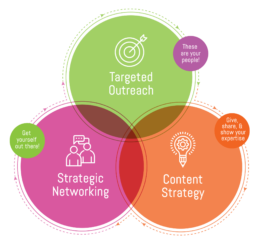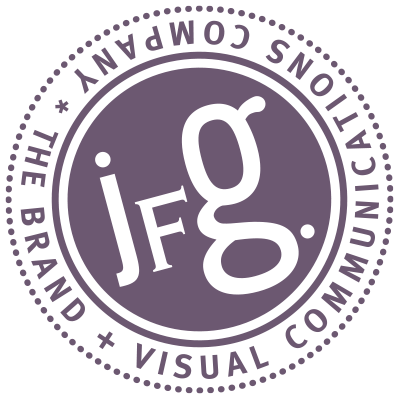Defining Your Marketing Strategy: Targeted Outreach
Your marketing strategy outlines the tactics you use to communicate with your ideal clients. It is derived from your brand strategy and is one of the three key strategies every successful business needs. According to Ilise Benun of Marketing Mentor, an integrated marketing strategy consists of targeted outreach, strategic networking, and content marketing. This post is the first of a three-part series that reviews each of these elements to help you focus your marketing efforts.

What is Targeted Outreach?
Targeted outreach is a focused, time-bound effort to connect with a list of specific individuals who fit your ideal client profile. Your primary goal is to start a conversation with your prospective clients so you can establish trust and build a relationship. One way to connect is through an outreach campaign. Your campaign should be comprised of a series of steps and a combination of tactics designed within a scheduled timeframe. Each touchpoint should be uniquely created to achieve a specific, measurable goal. Whether you decide to send a series of emails, a printed piece, or both, ask yourself, what is the best way to reach out to your ideal prospects? Below are five steps to help you develop and effective target outreach campaign:
1. Define Your Audience
Whom are you trying to reach? To run an effective targeted outreach campaign, you need to know the name, title, and contact information of the 25, 50, or 100 individuals with whom you want to build a relationship. Make sure you have the right contact person at each company and refine your list until it includes only the most qualified prospects. As you define your audience, you’ll start to learn about the conferences they attend, the associations they belong to, and the resources they rely upon to do their jobs. You may also see how active they are on social media or how involved they may be with specific organizations. This information will help you decide on the best way to approach them.
If you need a place to start: Make a list of 50 companies with whom you’d like to do business. To compile this list, start with your LinkedIn connections or other members on an industry-focused Slack channel. But don’t stop there. Review the membership lists of relevant associations or use a searchable database like AtoZDatabases.
2. Do Your Research
Now that you have your list in hand, it’s time to understand what each person on the list is struggling with that you could solve. The more you understand their challenges and what they’ve done to solve the problem, the more effectively you can tailor your message. Think about why the people on this list should work with you instead of another service provider. What’s in it for them? Research their company websites and social media channels. Define why they are your ideal client and how you can help them. Try to discover areas or topics that you are both passionate about and see if you can find common ground or a shared connection.
If you need a place to start: One of the easiest ways to understand your prospective client’s challenges is to speak to them directly, but cold calling isn’t always successful or comfortable. So instead, start by reviewing their LinkedIn profile. Do you have any company affiliations in common? Did you attend the same college or university? Do you have a shared connection? Perhaps both of you are members of the same group on LinkedIn? Did you attend the same event? Find things that connect you and them, and incorporate those commonalities into your outreach message.
3. Craft Your Message
Okay, so you have your list, and you’ve done your research. Now it’s time to choose the words that best speak to your prospective client’s challenges and pain points. Your message has to answer one question: what’s in it for them? It isn’t a pitch. It’s a conversation starter, and your goal is to elicit a response. Your outreach campaign should talk to them not as a service provider to a prospective client, but as a friendly colleague looking to build a long-term relationship. Show that you understand the challenges and their pain points. Speak to their needs and aspirations, and acknowledge their accomplishments. Be authentic and creative, and show them how you are uniquely qualified to solve their problem. Each time you follow-up, or provide information that they can use, you add more value to the conversation. (This is where the overlap with content marketing comes into play.) As you develop these messages, think about how each message naturally leads to the next, leading your prospect to respond.
If you need a place to start: Decide how you want to reach out to the people on your list. Do you want to use LinkedIn? A personal email? A direct mail piece? In each version, what are you asking? What is the overarching message that addresses their challenges and pain points? How are you showing that you know about their business and can help? Can you come up with a creative concept that would grab their attending and speak to their challenges, needs, or business aspirations?
Related Article: Defining your Marketing Strategy Part 3: Content Marketing
4. Define Your Campaign
So with steps 1-3 complete, how will you best reach out? It can take up to 10 touches to convert a lead into a customer, so you’ll need to craft a robust follow-up sequence that encourages the recipient to engage with you. Review your research, findings, and customized messaging and clearly define the purpose and timeframe of your campaign. I find that a combination of direct mail and email marketing is an effective method. These efforts can be supported by reaching out on social media as well. Be creative and think outside of the norm. For your direct mail campaign, go beyond the postcard. Consider creating a customized package to serve as the cornerstone of your campaign. Create a series of follow-up email messages that carry the campaign theme forward and deepen the relationship.
If you need a place to start: Conduct a three-month, targeted outreach campaign to secure 25 clients next quarter. In month one, reach out with a direct mail piece, follow-up with an email asking if they received it, and send a connection request on Linked In. In month two, let them know you’ll be attending a conference where their CEO is speaking and try to set up a time to meet. In month three, attend the conference and, afterward, call your prospect to share notes about the experience and determine if there is any interest in a further conversation. Set your goals and make sure they are SMART — specific, measurable, attainable, relevant, and time-bound.
5. Build the Relationship
With all your efforts, your ideal clients are bound to take notice. Timing is everything; even though they may not need you at the time of the campaign’s last touchpoint, it doesn’t mean that they won’t remember you when the need arises a few months later. Persistence and consistency are vital. Even after your campaign’s engagement ends, keep building the relationship through the connections you established.
You’re connected. Now what? Continue to send valuable resources and nurture that relationship. Introduce them to someone else who works in the same industry, if you think that relationship will add value to both parties.
Are You Ready to Launch a Targeted Outreach Campaign?
A targeted outreach campaign is one of three legs of your marketing strategy. It works in concert with strategic networking, which may help you identify prospects for your targeted outreach, and content marketing, which provides at least some of the valuable content you share in your outreach campaign. By creating and implementing a comprehensive marketing strategy, you will attract more of the right-fit clients.
Are you ready to focus on your marketing strategy and need assistance in launching a targeted outreach campaign? Let’s talk.
BRAND ESSENTIALS FOR THE ENTREPRENEUR
Read more about branding, strategy, and visual communications.
JFG VISUAL COMMUNICATIONS
Are you ready to elevate your business to the next level?
Regardless if you’re in the starting phase of your business or in the position to take your start-up to the next level, you don’t have to do it alone. Learn more by scheduling a complimentary 30-minute consultation and let's get started today!




